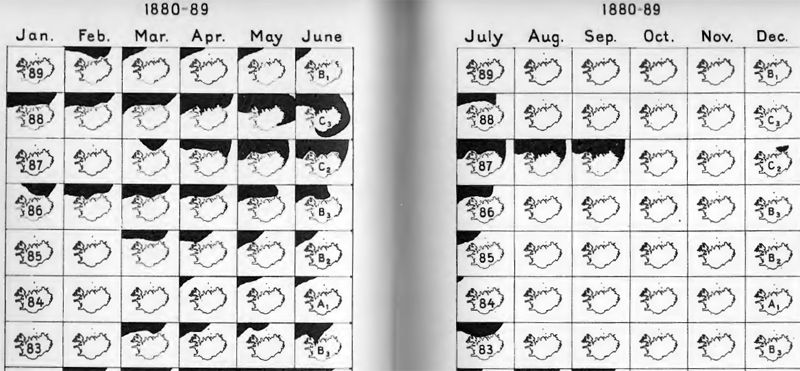In the past 150 years or so the south coast of Iceland is the nearest that the Arctic sea ice has advanced to those of us in NW Europe.
I remember back in the pre-internet 1980s, when access to meteorological data was very limited, always being intrigued by the BBC Shipping forecast especially in winter or early springtime when you would occasionally hear mention of "
light icing" or even moderate or severe icing warnings. Different times.

I came across this article of maps showing ice extent around the coasts of Iceland covering period of 1877 to 1968 (cropped image attached) :
http://www.vedur.is/media/hafis/frodleikur/is_koch_hlynur_1877-1968.pdf
The maps are largely the work of Lauge Koch (covering period pre 1940) and Hylner Sigtryggsson (post 1940) which probably explains why the maps are not listed in chronological order but begin with 1939 back to 1877 and then progressing from 1941 to 1967. While maps give a fairly good overview of the position of the ice this season can not take them too literally. Usually a maximum spread of the month rather than a typical spread. Koch used maps and other information to create a measurement number of ice spread from year to year. The so called Koch Index.
1881 is regarded as the severest ice year in the past 200 years. As early as January the whole northwest, north and east coasts were blocked by ice. In April the ice began to spread to the south coast and in May a very broad belt of ice extended along the east coast with a broad belt also along the south coast as far as Reykjanes peninsula.
Here is my chronology of sea ice around Iceland :
1878 : Ice Mar-Jun along north coast
1881 : Severest ice year
1882 : Not much better. Ice along parts of north coast even in September.
1887 : Ice along all of the north coast through August and September. That was some export through the Fram !! This year also corresponded with a remarkably dry anticyclonic dominated year over NW Europe.
1892 : Another severe year but after this conditions improved.
1911 : Next severe year.
1918 : Another severe year
1926 & 1927 : Two low ice years in a row.
1931 : Ice hardly visible on any monthly map. Akin to most recent years.
1934-1936 : Three low ice years in a row.
1944 : Ice back on north coast Mar-Apr
1965 : Conditions something like the late 19th century. This was the beginning of the so called Icelandic "Ice Years". 1965-1971.
1972-1978 : Some warming again
1979-1986 : Cold period
1987 : Warming again with one cold year in 1995.
2010 : Ice comes close to the north coast in January and later in December. On January 27 a polar bear was shot in the NE of the country. According to
this report the bear’s arrival in Iceland is highly unusual. Two polar bears were shot and killed in Iceland in the summer of 2008 and no others had been spotted for around 20 years before.
(Since 2010 there has been another report of a polar bear shooting in the NW of the country in summer 2016. Unlikely to be ice related. The head of the Icelandic Institute of Natural History believed it most likely that the bear swam a huge distance from the coast of Greenland.)
